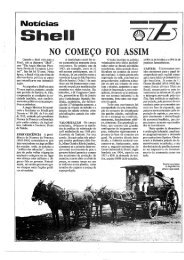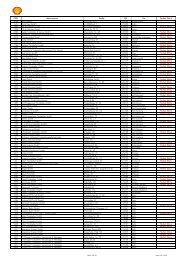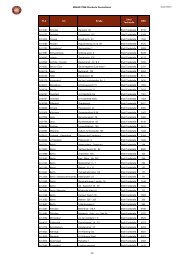Safety Data Sheet
Safety Data Sheet
Safety Data Sheet
You also want an ePaper? Increase the reach of your titles
YUMPU automatically turns print PDFs into web optimized ePapers that Google loves.
<strong>Safety</strong> <strong>Data</strong> <strong>Sheet</strong><br />
Low Boiling Point Naphtha<br />
Version 2.2<br />
Effective Date 14.06.2012<br />
IMO (International Maritime Organization) MSDS<br />
per SOLAS regulation VI/5-1<br />
Fish<br />
product required to prepare aqueous test extract.<br />
: Expected to be toxic: LL/EL/IL50 1-10 mg/l<br />
Aquatic crustacea : Expected to be toxic: LL/EL/IL50 1-10 mg/l<br />
Algae/aquatic plants : Expected to be toxic: LL/EL/IL50 1-10 mg/l<br />
Microorganisms : Expected to be harmful: LL/EL/IL50 10-100 mg/l<br />
Mobility : Floats on water. If product enters soil, one or more constituents<br />
will be highly mobile and may contaminate groundwater.<br />
Persistence/degradability : Oxidises rapidly by photo-chemical reactions in air and water.<br />
Major constituents are expected to be inherently<br />
biodegradable. Not Persistent per IMO criteria. International Oil<br />
Pollution Compensation (IOPC) Fund definition: “A nonpersistent<br />
oil is oil, which, at the time of shipment, consists of<br />
hydrocarbon fractions, (a) at least 50% of which, by volume,<br />
distills at a temperature of 340ºC (645ºF) and (b) at least 95%<br />
of which, by volume, distils at a temperature of 370ºC (700ºF)<br />
when tested by the ASTM Method D-86/78 or any subsequent<br />
revision thereof."<br />
Bioaccumulative<br />
: Contains constituents with the potential to bioaccumulate.<br />
Potential<br />
Other Adverse Effects<br />
13. DISPOSAL CONSIDERATIONS<br />
: Films formed on water may affect oxygen transfer and damage<br />
organisms.<br />
Material Disposal<br />
: Recover or recycle if possible. It is the responsibility of the<br />
waste generator to determine the toxicity and physical<br />
properties of the material generated to determine the proper<br />
waste classification and disposal methods in compliance with<br />
applicable regulations. Waste arising from a spillage or tank<br />
cleaning should be disposed of in accordance with prevailing<br />
regulations, preferably to a recognised collector or contractor.<br />
The competence of the collector or contractor should be<br />
established beforehand. Do not dispose into the environment,<br />
in drains or in water courses. Do not dispose of tank water<br />
bottoms by allowing them to drain into the ground. This will<br />
result in soil and groundwater contamination. MARPOL - see<br />
International Convention for the Prevention of Pollution from<br />
Ships (MARPOL 73/78) which provides technical aspects at<br />
controlling pollutions from ships.<br />
Container Disposal : Drain container thoroughly. After draining, vent in a safe place<br />
away from sparks and fire. Residues may cause an explosion<br />
hazard. Do not, puncture, cut, or weld uncleaned drums. Send<br />
to drum recoverer or metal reclaimer. Do not pollute the soil,<br />
water or environment with the waste container.<br />
Local Legislation : Disposal should be in accordance with applicable regional,<br />
national, and local laws and regulations. Local regulations may<br />
be more stringent than regional or national requirements and<br />
must be complied with.<br />
12/14<br />
Print Date 15.06.2012 000000021522<br />
MSDS_IMO






![Download Shell AutoGas Stationen [Stand: August 2011]](https://img.yumpu.com/7453880/1/184x260/download-shell-autogas-stationen-stand-august-2011.jpg?quality=85)